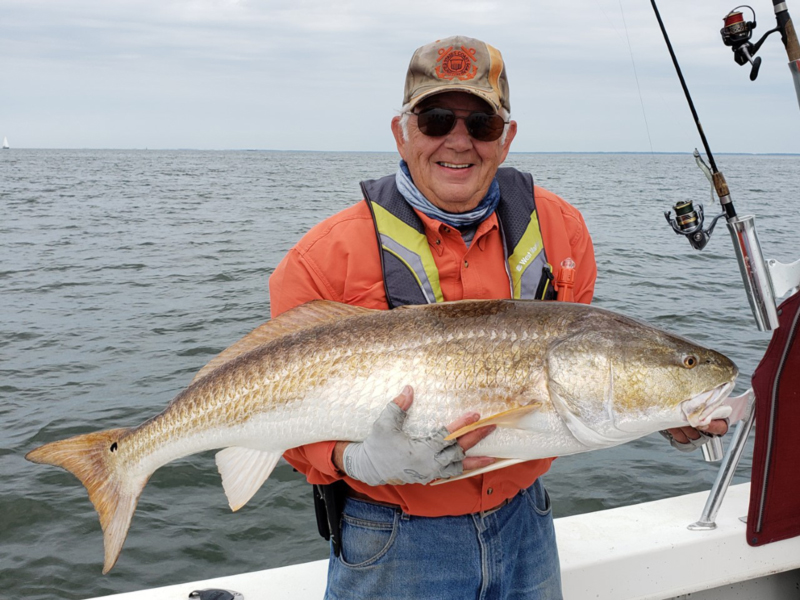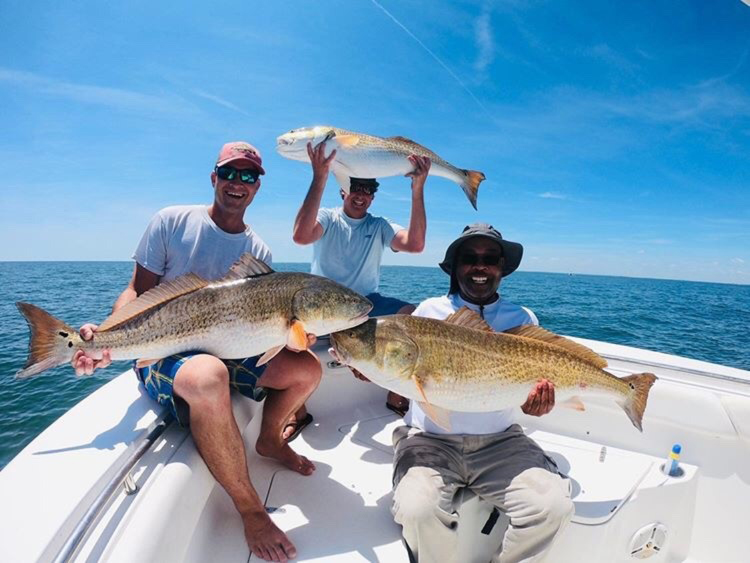For many years, all of the big red drum I caught were on live or cut bait like crabs, menhaden chunks, spot, or croaker. And that is an excellent way to catch them, particularly in late spring. We usually sat at anchor in a location where we believe the fish to be and put out baits on relatively heavy conventional tackle. After that, it was a sit and wait scenario. Sometimes fishing like this is great, sometimes it isn’t. In recent years I have increasingly targeted them with artificial lures on spinning tackle. This is a totally different approach.

Big Fish, Small Tackle
When fishing with artificials, I use lighter spinning tackle and cast to the fish. I have caught them mostly on 10- to 20-pound braid, spooled on 2500 or 3000 size spinning reels. I prefer Penn Battle II and III reels for this. They are rugged reels with HT-100 Carbon Fiber Drag Washers. Before you complain that this is an advertisement for Penn, let me tell you that I plan on also using a Diawa Fuego reel this year. The Diawa is lighter but is also a strong inshore reel. This is not “specialized” gear. These are the same outfits I use for much of my inshore fishing.
On the business end, I tie about three feet of a 20- to 30-pound leader (fluorocarbon or monofilament). I then add a half to three-quarter ounce leadhead jig. I dress the jig with any of an assortment of plastic tails, mostly from Gulp!, Salt Strong, and Z Man. Okay, no more product placement. (Editor’s note: Chuck, you haven’t mentioned a single FishTalk advertiser yet — Dang!!)
First, let me define “big reds.” I’ll start by saying I love catching red drum in any size from small puppy drum, to slot reds (18 to 26 inches – the legal size to keep three red drum in Virginia, and 18 to 27 in Maryland where you can keep one), to the next size up (27 to 39 inches), to the big ones (over 40 inches). All of them fight well for their size. This article is about those trophy fish over 40 inches.
You’ll probably say at this point that the tackle I am using is too small for the really big ones. And you may be right. I have lost my share of big drum during the fight. But there is just something about catching big fish on light tackle that really excites me.
Where to Look for Bull Redfish
I catch most of these fish within 100 feet of one of the islands of the Chesapeake Bay Bridge-Tunnel (CBBT). I mostly fish around the first and second islands, but that has more to do with the small size of my boat than anything else. This is primarily a summer fishery, and usually a “plan B” on any given trip. By this I mean I rarely go out with the idea of targeting big drum in specific. But, if they are around, I will quickly change up to fishing for them. I always keep a rod ready in case they show up.
I use two different but similar techniques for red drum on jigs. Often when I am anchored and fishing for other species such as spadefish, trigger fish, or bluefish, I will make some casts for red drum as well. There are a few particular spots that have worked well for me. Without giving these away, I would suggest looking for places along the rocks that are different — where the island curves in or out. Often big reds will hold close to the rocks in these locations, waiting for lunch to swim by.
I cast my jig so that it sinks within several feet of the rocks. When it hits bottom, I will begin working it back to the boat raising the rod tip with a jigging motion, and then allowing the bait to sink back to the bottom. You will lose a few rigs to snags, but that is just part of the game.
The bite is often soft. Sometimes it takes a few seconds to realize you have a big fish on the line. I imagine in those first few seconds the fish may not even realize it is hooked. On other occasions, the fish will hit like a freight train and just keep going. Be ready for either type of bite.
When the red drum are schooled up and moving around, I use another method of catching them. I may spot them swimming a few feet under the surface, or I may pick them up on my fish finder. When I locate the school, I try to avoid plowing through them. I cast my jig in front of the direction they are headed and let the lure sink through the school.

Sometimes, you will feel your lure bumping through the school before you get a bite. Once your lure is below the school, reel it in and try again. Red drum aren’t very picky eaters. Casting a jig to a school usually results in a bite.
Landing Bull Redfish
When I get a strike I pull the rod tip up sharply to set the hook, and the fish usually takes off on a long run. Whatever you do, don’t try to stop the fish! In fact, I work with my drag set a little loose so that the line won’t break during this initial run. If I am anchored, I can choose to fight the fish from there or pull the anchor and follow the fish. If I am not anchored, I can just chase the fish. Either way, it is usually a long fight.
There are two deciding factors about chasing the fish or fighting from anchor. If I am alone, I usually just stay anchored. It is really hard to pull the anchor while fighting a fish. The other factor is the presence of other boats in the area. Obviously, I can maneuver around other boats if I am not anchored. For some reason, it seems that big reds like to head straight for another boat when hooked.
Following the first long run, the fish usually takes several shorter runs. Between runs, it is a matter of slowly working the fish towards you and trying to get line back on the reel. I usually find the hardest part of the fight is when the fish is within 10 feet of the boat. At this point it takes patience not to tighten down the drag and try to haul the fish in. I have lost my share of fish near the boat, and I have broken two landing nets on big red drum beside the boat. So, these days I take my time and I try to land them without the use of a net.
I only bring them aboard to measure the fish and get a quick picture before releasing them. I ease the fish back into the water, and holding it by the mouth, move the boat slowly forward to get water moving through the fish’s gills. The fish will let you know when it is ready to swim off.
If I decide to keep fishing for them after landing one, I always replace my leader. This line will be stretched and probably nicked up. A few feet of leader line is a small price to pay for the chance to land another trophy fish.
Of course, the CBBT is not the only place to find large reds. The first ones in our region each year are typically landed on Eastern Shore beaches. In late spring they come into the Bay near Fisherman’s Island. Many of these fish work their way down the bridge-tunnel in summer. Others continue up the Bay to other locations. You may even get lucky enough to spot a large school of reds near the surface in open water, as they migrate out in late summer or early fall.
You can get a citation plaque from the Virginia Saltwater Fishing Tournament for released drum over 46 inches. Citation forms are available at many locations around the state. You will need to provide the signature of a witness or a picture showing the length of the fish, but a good picture taken in a small boat of a four-foot-long fish beside a ruler, is difficult. Ask me how I know!
-By Chuck Harrison